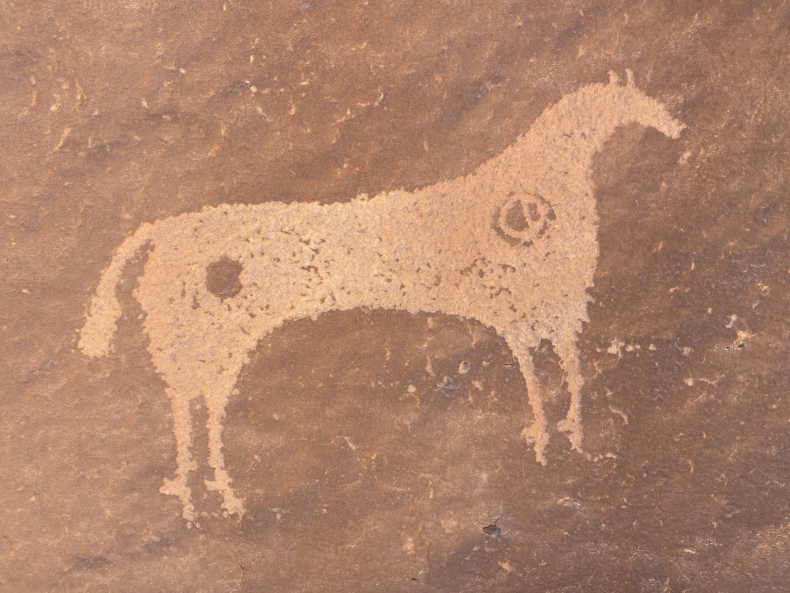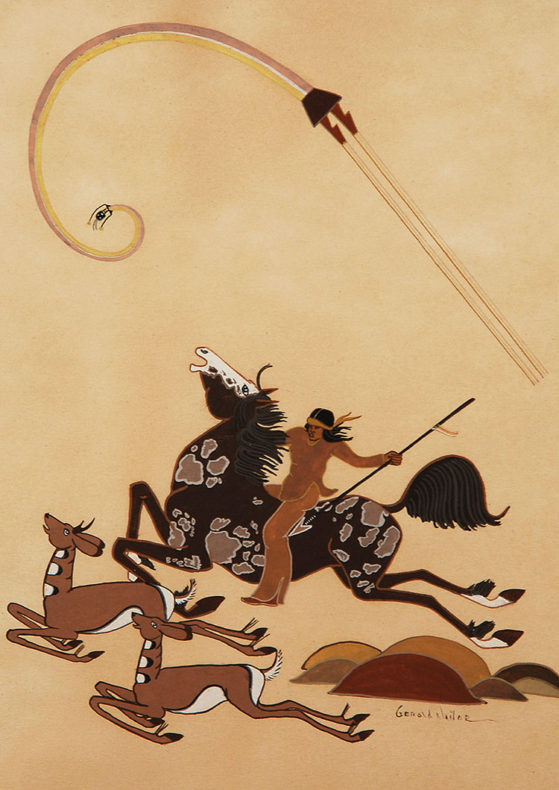
My mother is an artist, and when she was a kid in New Mexico she’d draw horses in a Southwestern style, jaunty spring in their step and delicately curved, a bit like the art of Navajo, Acoma, or Zuni, all of which could have influenced her. The other day, I came across a couple of her horses on a boulder. Or horses that look like hers. The style I’m sure seeped through, even from a great distance.
Two horses in a row facing left to right were Ute in origin, a couple centuries old at least. They had been meticulously chipped with bone or antler into a natural canvas of mud-red sandstone, the one farthest left given special attention, its lines sharp, form impeccable, as if rendered on a wall in Lascaux. On its rump and shoulder it bears what looks to represent a pair of brands or painted circles, moons of different phases perhaps, a pronouncement about the horse, its rider, or the people it represents. Art within art.
Near the foot of the San Juan Mountains in the Four Corners, territory of the Utes, there is little doubt as to the cultural origin of these horses. Form is a giveaway. They remind me of what my mother drew on what is now yellowed paper that she might still have at the bottom of a box somewhere, art of a schoolgirl born and raised in the Southwest, picking up styles and messages around her.
A Ute friend rolls her eyes at Ute horse art when it comes up, saying her people aren’t horse people. She prefers the sturdier hunter gatherer days, the true history of Ute. But many had horses, stolen, traded, bought and sold, rode for their utility, their power, the ability to cross hundreds of miles in short order. Whatever it was, the feeling had been imbued into stone. I’ve seen them all across the Southwest, Navajo horses etched or painted in the backs of stone alcoves, Apache horses on canyon walls. Once it entered the lexicon, the horse became a rock art favorite.
The two horses, both with moons or circles, are in a steep bay of a canyon where rock is busy with art. The rest of the art is older, dating to atlatl days when people used throwing spears, before bow and arrow, before domestic horses in America, at least a thousand years ago. The two Ute horses are much more recent, but I noticed they hadn’t been pecked atop earlier rock art. This canvas had been left clean, as if for them. They were next in line: Spanish horses bred by Native Americans, spreading like wildfire among the hunting tribes.
My mom picked up the style in 4th grade while researching New Mexican history, thumbing through magazines to study the art of the day. Who she saw, she doesn’t remember. It may have been famed Potawatomi artist Woody Crumbo (1912-1989) from Oklahoma, whose horses are electrified, suppleness and strength making a spring-loaded powerhouse of an animal in vivid colors. Or it may have been Navajo studio artist Gerald Nailor (1917–1952) from New Mexico who worked in Santa Fe where my mom lived during her elementary school years before the family moved to the southern part of the state. Nailor’s image below was painted when he was 17, living in the town of Picuris.
There is a ‘Bambi’ quality to the art, a cuteness picked up by Disney in the 40s, which was appropriated from the likes of Native artist Pop Chalee whose slender deer and enchanted forest paintings went on exhibit in 1936, the year before brush went to paper making “Bambi.” Chalee was a student of Dorothy Dunn, a white art teacher who created The Studio School at the Santa Fe Indian School in 1932. Dunn taught a simple “flatstyle” painting with solid color fields, minimal backgrounds, and little shading or perspective. Some have complained it was unoriginal and repetitive, but it became a Native American mid-century mainstay. A dozen or so prominent Native artists including Chalee came through Dunn’s school where the teacher insisted her students use Native American subjects and a flat-art style, something she’d picked up while teaching at the New Mexico pueblos, and also saw in rock art around the region. Wherever it originated, the style settled in easily to the older form of the horse. Crumbo and Chalee’s horses, like Nailor’s, went from cute to enflamed, manes erupting, a package of passion.
Maybe all girls in 1950s New Mexico grew up drawing the same horses springing across art deco yuccas and tufts of grass, fetlocks flashing, hooves flying over the ground. This is how styles and ideas move, my mom in bobby socks sitting atop her bedcovers shading notebook pages with colored pencils. Without knowing it, she sent the image forward, slipping it like a note to the next in line, me standing before a pecked rock face in the desert, seeing a horse I think I know.

Top photo by Craig Childs
Bravo!
17th century Master Ecuyer La Gueriniere said ‘ we ride horses for the pleasure of ‘creating beauty’ even when the horses were used for war duty. He speaks of a beauty that is unique to the moment when humans and horses become one through a conversation between two souls. A beauty that is equivalent to the Dine’ construct of Ho’zho’ -whereby one walks in the beauty of self-awareness, happiness, and contentment of heart. A beauty that is portrayed by a universal art shape that transcends any era of time or space but known uniquely to those who are fortunate enough to have their lives graced by the company of horses.
Beautifully said Jennifer, thank you.
When my daughter was little, she and I spent hours poring over the books of Paul Goble, whose art was highly stylised but whose plants and animals were always, always recognisable and accurately portrayed. My wife, I later learned, had enjoyed Paul Goble’s work in her own childhood; she has recently been considering a Goble-inspired tattoo. Until now, I had been unaware of Woody Crumbo, Gerald Nailor, and Pop Chalee, but their influence on Goble is unmistakable. Thanks, Craig, for bringing them to my attention; I’ll be sharing your post with Ellie and Jessa both.